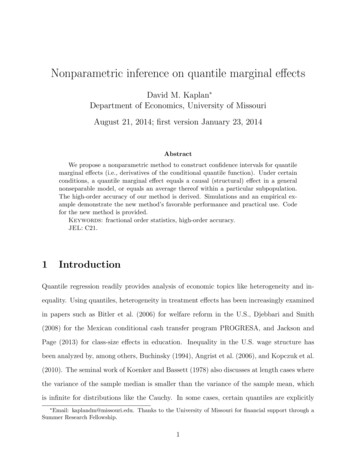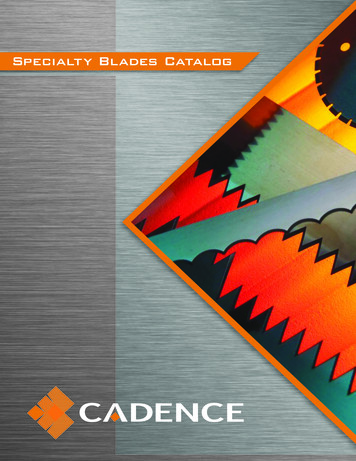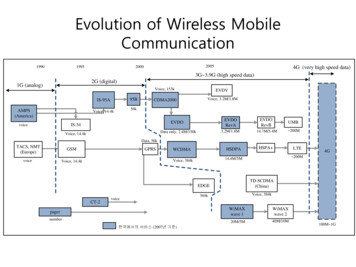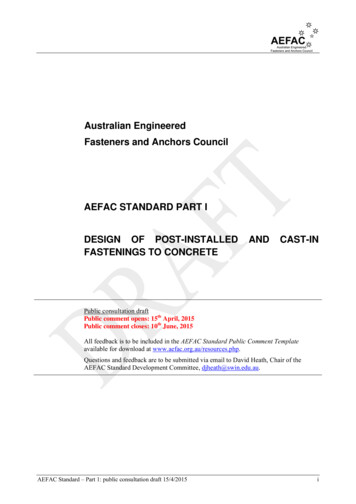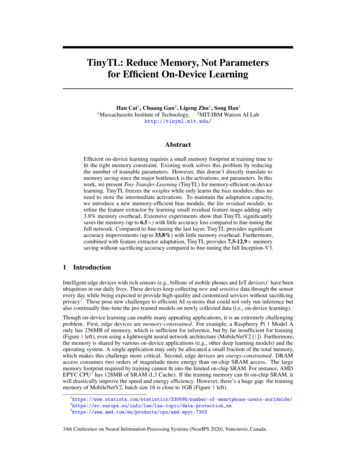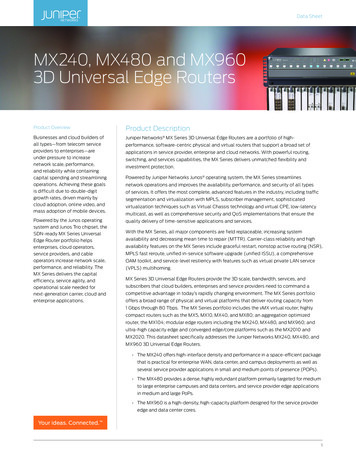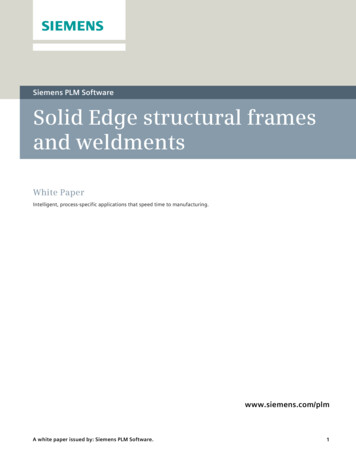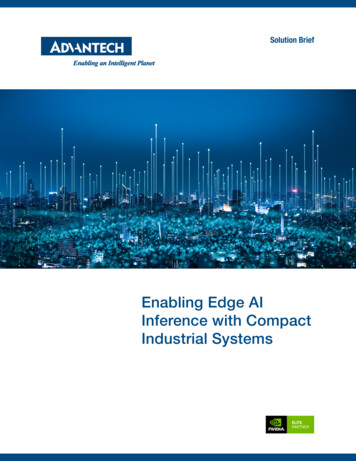
Transcription
Solution BriefEnabling Edge AIInference with CompactIndustrial Systems
Solution BriefExecutive SummarySolution HighlightsAdvantech bringsdecades of real-worldexperience in industrialcomputing to AI inferencesystems featuring: Full range of NVIDIA Jetson systemon-modules, eachcombining Arm processor cores withNVIDIA GPU coresComprehensivesoftwareinfrastructureincluding the NVIDIAJetPack SDK,enabling manymachine learningframeworks andmodels, and severalmultimedia, scientific,and computer visionlibraries.Designed for missioncritical operation, easydeployment, and longlifecycles, use cases forthese edge AI inferenceplatforms include IoTsensor and controlprocessing, multi-channelimage classification,motion control, and moresmart automation needs.Artificial intelligence (AI) technology breaks away from static rulebased programming, substituting inference systems using dynamiclearning for smarter decisions. Advanced AI technology combinedwith IoT technology is now redefining entire industries with smartapplications.AI IoTSmarter, mission-critical applications:AgricultureMaterial uringTransportationAn important trend across these industries is the shift of AIinference systems toward the edge, closer to sensors and controlelements, reducing latency and improving response. Demandfor edge AI hardware of all types, from wearables to embeddedsystems, is growing fast. One estimate sees unit growth at 20.3%CAGR through 2026, reaching over 2.2 billion units. *The big challenge for edge AI inference platforms is feeding highbandwidth data and making decisions in real-time, using limitedspace and power for AI and control algorithms. Next, we see howthree powerful AI application development pillars from NVIDIA arehelping Advantech make edge AI inference solutions a reality.* Data Bridge Market Research, Global Edge AI Hardware Market – Industry Trends andForecast to 2026, April 2019.Copyright 2021 Advantechwww.advantech.com
Solution BriefWhat is AI Inference?There are two types of AI-enabled systems: those for training,and those for inference. Training systems examine data sets andoutcomes, looking to create a decision-making algorithm. For largedata sets, training systems have the luxury of scaling, using servers,cloud computing resources, or in extreme cases supercomputers.They also can afford days or weeks to analyze data.Edge AIinferencesupports whatis happeningtoday in anapplication– and looksahead monthsand years intothe future asit continueslearning.The algorithm discovered in training is handed off to an AI inferencesystem for use with real-world, real-time data. While less computeintensive than training, inference requires efficient AI accelerationto handle decisions quickly, keeping pace with incoming data. Onepopular option for acceleration is to use GPU cores, thanks to familiarprogramming tools, high performance, and a strong ecosystem.Traditionally, AI inference systems have been created on server-classplatforms by adding a GPU card in a PCIe expansion slot. Most AIinference still happens on AI-enabled servers or cloud computers, andsome applications demand server-class platforms for AI accelerationperformance. Where latency and response are concerns, lower powerembedded systems can scale AI inference to the edge.Advantages of Edge AI Inference ArchitectureEdge computing offers a big advantage in distributed architectureshandling volumes of real-time data. Moving all that data into the cloudor a server for analysis creates networking and storage challenges,impacting both bandwidth and latency. Localized processing closerto data sources, such as preprocessing with AI, can reduce thesebottlenecks, lowering networking and storage costs.There are other edge computing benefits. Personally identifiableinformation can be anonymized, improving privacy. Security zonesreduce chances of a system-wide breach. Local algorithms enforcereal-time determinism, keeping systems under control, and manyfalse alarms or triggers can be eliminated early in the workflow.Extending edge computing with AI inference adds more benefits. EdgeAI inference applications scale efficiently by adding smaller platforms.Any improvements gained by inference on one edge node can beuploaded and deployed across an entire system of nodes.If an edge AI inference platform can accelerate the full applicationstack, with data ingestion, inference, localized control, connectivity,and more, it creates compelling possibilities for system architects.Copyright 2021 Advantechwww.advantech.com
Solution BriefExtended lifecyclesupportNVIDIA Jetson modulescome in commercialversions with 5-yearguaranteed availability,and select industrialversions offer 10 years.Flexibility of CPU GPU Engines for the EdgeNVIDIA developed the system-on-chip (SoC) architecture used in theNVIDIA Jetson system-on-module (SoM). As applications for themgrew, these small, low power consumption SoCs evolved with fasterArm CPU cores, advanced NVIDIA GPU cores, and more dedicatedprocessor cores for computer vision, multimedia processing, and deeplearning inference. These cores provide enough added processingpower for end-to-end applications running on a compact SoM.AI inference can be implemented many ways. There are single-chipAI inference engines available, most with 8-bit fixed point math andoptimized for a particular machine learning framework and AI model.If that framework and fixed point math works, these may do the job.NVIDIAJetson NanoNVIDIAJetson TX2Many applications call for flexible CPU GPU engines like those onJetson modules. With AI models ever changing, accuracy, a choice offrameworks, and processing headroom are important. Inference mightneed 32-bit floating point instead of 8-bit fixed point math - precisionexperiments on a CPU GPU engine are easy. If research suggestsan alternative inference algorithm, GPU cores can be reprogrammedeasily for a new framework or model. As control algorithms get moreintense, a scalable multicore CPU handles increased workloads.Pillar 1: Scalable System-on-Modules forEdge AIFrom entry-level to server-class performance, NVIDIA Jetson modulesare the first of three pillars for edge AI inference. Sharing the same codebase, Jetson modules vary slightly in size and pinout, with featureslike memory, eMMC storage, video encode/decode, Ethernet, displayinterfaces, and more. Summarizing CPU GPU configurations:NVIDIAJetson Xavier NXNVIDIAJetson AGX XavierCopyright 2021 AdvantechJetson NanoJetson TX2 SeriesJetson Xavier NXJetson AGX XavierAI Inference472 GFLOPS1.33 TFLOPS21 TOPS32 TOPSGPU128-Core NVIDIAMaxwell GPU256-Core NVIDIAPascal GPU384-Core NVIDIAVolta GPU, with 48Tensor Cores512-Core NVIDIAVolta GPU, with 64Tensor CoresCPUQuad-Core ArmCortex-A57Dual-core NVIDIADenver 2 andQuad-Core ArmCortex-A576-core NVIDIACarmelArm-v8.28-core NVIDIACarmelArm-v8.2For a complete comparison of NVIDIA Jetson module features, d-systems/www.advantech.com
Solution BriefPillar 2: SDK for Edge AI InferenceApplicationsTwo more SDKsfor AI developersNVIDIADeepStream SDKDeepStream SDKis a streaminganalytics toolkit forAI-basedIoT sensorprocessing,including videoobject detectionand imageclassification.NVIDIA Isaac SDKIsaac SDKincludes buildingblocks and toolsfor creatingrobotics withAI-enabledperception,navigation, andmanipulation.The second pillar converts a large base of NVIDIA CUDA developersinto AI inference developers, with a software stack running on anyNVIDIA Jetson module for “develop once, deploy anywhere”.The NVIDIA JetPack SDK runs on top of L4T with an LTS Linux kernel.It includes accelerated libraries for cuDNN and TensorRT frameworks,as well as scientific libraries, multimedia APIs, and the VPI andOpenCV computer vision libraries.JetPack also has a NVIDIA container runtime with Docker integration,allowing edge device deployment in cloud-native workflows. It hascontainers for TensorFlow, PyTorch, JupyterLab and other machinelearning frameworks, and data science frameworks like scikit-learn,scipy and Pandas, all pre-installed in a Python environment.Developer tools include a range of debugging and system profilingtools including CPU and GPU tracing and optimization. Developerscan quickly move applications from existing rule-based programminginto the Jetson environment, adding AI inference alongside control.For a complete description of NVIDIA Jetson software features, rePillar 3: Ecosystem Add-Ons for CompleteSolutionsThe third pillar is an ecosystem of machine vision cameras, sensors,software, tools, and systems ready for AI-enabled applications.Over 100 partners work within the NVIDIA Jetson environment, withqualified compatibility for easy integration. For example, several thirdparties work on advanced sensors such as lidar and stereo cameras,helpful for robotics platforms to determine their surroundings.Copyright 2021 Advantechwww.advantech.com
Solution BriefSystems for Mission-Critical Edge AI InferenceMany edge AI inference applications are mission critical, calling forsmall form factor computers with extended operating specifications.Advantech created the compact MIC-700AI Series systems, targetingtwo different scenarios with full range of performance options.Longevity andrevision controlWith extendedavailability of allcomponents,Advantech offersa 5-year lifecycleon all MIC-700AISeries platforms.Additionally,system revisionnotification isstandard, with fullrevision controlservices available.Adding AI inference to controlThe first scenario is the classic industrial computer, with a ruggedform factor installed anywhere near equipment requiring real-timedata capture and control processing. These scenarios often havelittle or no forced air cooling, only DC power available, and DIN railmounting for protection against vibration.For this, the MIC-700AI series brings AI inference to the edge. Designedaround the low-power NVIDIA Jetson Nano using advanced thermalengineering, the fanless MIC-710AI operates on 24VDC power intemperatures from -10 to 60 C. With an M.2 SSD, it handles a 3G,5 to 500 Hz vibration profile.Advantech MIC-710AI AI Inference SystemThe MIC-710AI features two GigE ports, one HDMI port, two externalUSB ports, and serial and digital I/O. For expansion, Advantech iDoormodules are mPCIe cards with cabled I/O panels (cutout seen on leftside above). iDoor modules handle Fieldbus, wireless, and more I/O.Advantech PCM-24S2WF iDoor Module with Wi-Fi and BluetoothCopyright 2021 Advantechwww.advantech.com
Solution BriefMid- to high-performance image classificationThe second scenario involves machine vision and image classification,where cameras look for objects or conditions. Systems often usePower over Ethernet (PoE) to simplify wiring.At the high end with the NVIDIA Jetson AGX Xavier, the MIC-730IVAprovides eight PoE channels for connecting industrial video cameras.It also provides two bays for 3.5” hard drives, enabling direct-to-diskvideo recording. The system runs from 0 to 50 C, using AC power.AdvantechMIC-730IVA8 Channel AINetwork VideoRecorderFrom off-the-shelfto customizedAdvantech canhandle localsourcing andintegration needs,and customizationincluding bezels,I/O, power,and otherneeds, creatingsolutions readyfor customerresale. For mostneeds, there is nominimum orderquantity (MOQ).A portfolio of AI-enabled solutionsAll MIC-700AI Series systems run the same software, enablingdevelopers to move up or down and get applications to market faster.NVIDIA Jetson ModuleAI Inference ControlImage ClassificationJetson NanoMIC-710AI/MIC-710AILMIC-710IVAJetson TX2 SeriesMIC-720AI-----Jetson Xavier NXMIC-710AIX/MIC-710AIXLMIC-710IVXJetson AGX XavierMIC-730AIMIC-730IVAThe latest MIC-710AIL features a Jetson Nano or Jetson Xavier NX inan ultra-compact enclosure, also with iDoor module expansionAdvantech MIC710AIL AI InferenceSystem (Lite)These systems bring AI inference to the edge in reliable, durableplatforms ready for a wide range of applications includingmanufacturing, material handling, robotics, smart agriculture, smartcities, smart healthcare, smart monitoring, transportation, and more.For more information on Advantech Edge AI systems, ystem/sub 9140b94e-bcfa-4aa4-8df2-1145026ad613Copyright 2021 Advantechwww.advantech.com
Solution BriefAdvantech Contact InformationHotline Europe: 00-800-248-080 Hotline USA: 1-800-866-6008Email: skyserver@advantech.comRegional phone numbers can be found on our website vantech.com/ncNVIDIA, CUDA, and Jetson are trademarks and/or registeredtrademarks of NVIDIA Corporation in the U.S. and/or othercountries.Arm and Cortex are trademarks or registered trademarks of ArmLimited (or its subsidiaries) in the US and/or elsewhere.Copyright 2021 Advantechwww.advantech.com
learning inference. These cores provide enough added processing power for end-to-end applications running on a compact SoM. AI inference can be implemented many ways. There are single-chip AI inference engines available, most with 8-bit fixed point math and optimized for a particular machine learning framework and AI model.
